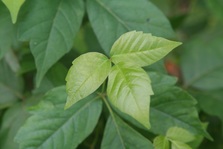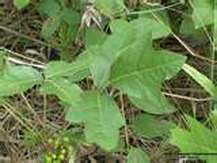
Poison Ivy

Poison Oak
Type in "poison oak or poison ivy treatment" on Google and you are overwhelmed with choices. What product works best? When you are scratching your skin down to the bone and losing sleep, people will reach for anything. The sensation of itch is called "pruritis" in medical terms. People say it is often worse than physical pain. The mind has a much more difficult time blocking out the itch sensation than it does painful stimuli. Because these plant rashes manifest differently across a spectrum of people, there is no "one size fits all" cure. The internet is full of drastic suggestions from pouring diesel fuel on it to scrubbing with pure bleach. I caution against this advice as I see permanent scarring and unacceptable pigmentary alterations long after the rash has faded. Since poison oak and ivy rashes resolve on their own in a few days to a few weeks without treatment, it is difficult to make any concrete causal relationships regarding what remedies work best. The following list is my professional opinion as a dermatologist. This list may be biased by the fact I see the most challenging cases; in that I see the folks that most over-the-counter (OTC) did not work for.
1. "Sasquatch Itch Cream": Ideally, you would not need this treatment, but the world is not perfect. If you have to reach for it, it probably means an itchy eruption is forming on your skin. I call this the "fire extinguisher of poison ivy" because it is formulated to sooth on contact and snuff out the smoldering rash. Once the resin binds to your skin cells, the outer membrane of the cell is permanently altered. The immune system no longer recognizes the skin cell as belonging to you and unleashes an attack against it. This is where Sasquatch Itch Cream works; it stomps out this attack. This product is not for the pure naturalist however, as it contains powerful synthetic anti-itch compounds and some cortisone. Sasquatch Itch Cream was designed for the military, specifically as a means to ensure the soldiers could complete their missions and not linger about the medic tent. Now it is used primarily by survivalists and hiking enthusiasts to make their adventures less irritating. Landscape professionals and telephone line climbers are also gravitating to this product en mass. In short, this product is designed with your misery in mind. It works. It works well. It works fast. One also has to love a product that "Sasquatch Endorses" (per the website). Retail: $24.99 Not available in store but a quick Google search will find it.
2. Rubbing Alcohol (isopropyl alcohol): As boring as this product sounds, nothing beats the price. Alcohol towelettes can purchased for pennies on the dollar compared to other washes and solvents. While, the resin of poison oak and poison ivy is not soluble in water, a few wipes of the alcohol towelette will do the trick. They travel well in almost any circumstances and environment. Most pharmacies carry them alongside their diabetic supplies, so don't be afraid to ask if you cannot find them in the aisles. Mineral spirits available at all hardware and art supply stores is another alternative. Retail: $3-$7 per 100 towelettes.
3. Benadryl (diphenhydramine): One of the substances released by your skin that causes itching is histamine. Diphenhydramine has been around since the second World War and is a potent blocker of the histamine receptor on skin cells. The mast cell lingers about within your skin just loaded with histamine granules. Under a microscope, it resembles a balloon filled with little marbles just waiting to pop. The release of these histamine granules is the primary conjuror of both the rash and the itch. The oral formulation can cause sedation and is the active ingredient in many night time sleep aids. Therefore, caution is advised if you are not sure how sensitive you are to it. This virtually ubiquitous cream is available at any grocery store, gas station, or pharmacy. Retail: $2-5 per 1-2 ounces. Non-sedating oral histamines include claritin, zyrtec, and allegra to name a few. None of these are currently available in topical formulation.
4. Calamine Lotion: This old standby will not go away-and for good reason. It is cheap and it offers a small degree of immediate relief. Zinc oxide and iron are the two major components but its anti-itch properties are attributed to the phenol inside. It is sold in many different formulations but my favorite is Caladryl (which contains generic benadryl as well). Everyone probably has a childhood summer memory of their bubble gum pink extremities compliments of grandma for that sunburn or poison oak rash. However it was not until several years ago that the U.S Food and Drug Administration came around to officially recommending its application for poison oak and poison ivy. Calamine works better if kept refrigerated in my experience. Retail $5-10
5. Technu: Short for "New Technology" this product serves mainly as a wash for the poison oak resin. This product is extremely popular and its parent company has been a marketing geniuses in its promotion. The main ingredient is deordorized mineral spirits and some alcohol compounds (See #2). While it does work for many people, a study in the International Journal of Dermatology concluded that it offered no cost benefit when compared to washing with Dial soap. Whatever method of washing off the resin one chooses, it needs to be done within 15 minutes of exposure. Once the resin has fused with your skin cells, the immune system will go ballistic and spawn that nasty rash. Of interest, Technu was first formulated to wash off radioactive dust in the 1960's. Retail: Technu $15-39.99.
6. Ivy Block: This is my favorite preventative product for poison oak and poison ivy. The idea of slathering impure clay on your skin to absorb plant resin sounds reasonable to any Neanderthal. But thank the good folks at Ivy Block for creating an elegant and safe formulation acceptable to modern man. The use of medicinal clay is well recorded in ancient Mesopotamia and Egypt and likely dates back much longer. A patented form of bentonite clay blocks the resin from encountering your skin's immune system. It should be applied 15-20 minutes before one anticipates exposure. I like this product because it is safe for children, effective, and with a little imagination connects us to our ancient medicinal roots. It is such a good absorber of oil that bentonite can be used to treat acne and excessive oiliness of the skin (Clearasil is a such a product). Retail $8.99-25.99.
7. Gold Bond Itch Cream: Gold Bond, originally made by Tennesseans and later sold to the French, combines topical zinc with the soothing calm of menthol and pramoxine. All the major pharmacy chains carry their own generic version for a few dollars less. Retail: $4-5 per 1-2oz tube.
8. Hydrocortisone: Perhaps nothing evokes as much fear in my patients as hydrocortisone. People automatically recall images of a bloated relative that had been taking "cortisone pills" for years. It is hard to get in trouble with over-the-counter strength topical hydrocortisone if used for a week or two. Like Sasquatch Itch Cream, it shuts down the inflammation on a cellular level. However, it does not provide any immediate or intermediate relief. A good slathering of hydrocortisone can take up to 48 hours to start taking effect. Technically it can purchased OTC in 2.5% but it is hard to find, as the 1% seems to be the manufactures' preference. Retail: $3-7 1-2 ounces (usually more if mixed with aloe).
9. Ivarest: Billed as a "Dual Relief" cream, Ivarest Poison Ivy Itch Cream is a reasonably sound product at a good price. It contains generic benadryl (see 3) and calamine (see 4). There is also some benzyl alcohol that soothes on contact. What I like about Ivarest is the tone-neutral calamine it contains. Other than the smell and mild residue it leaves behind, one cannot tell you have it on. It is an elegant formulation at the right price for mild poison oak & ivy discomfort. Retails: $4-8 bottle. Ivarest also is sold as a wash in a liquid-to-foam technology. I am not aware of any credible studies on this wash compared to Technu or just plain soap. I have a feeling it would not compare any more favorably to soap or rubbing alcohol than Technu did however.
10. Triamcinolone Injection: Yes this is not available over-the-counter and perhaps does not belong on this list. But it is my workhorse in the office. If the above treatments fail you, a good intramuscular slug of triamcinolone will get you back to your old self. It is readily available in nearly every ER and doctor's office. Cost: $30-100 (plus office visit)
Of course the best treatment is prevention. Learn what noxious plants in your area look like and how to identify them. To learn more about poison oak & ivy, you may wish to read the article "A Dermatologist Ponders Poison Oak".
By Dr. Derrick Adams, Board Certified Dermatologist
Vita Dermatology and Laser Institute
Red Bluff, CA